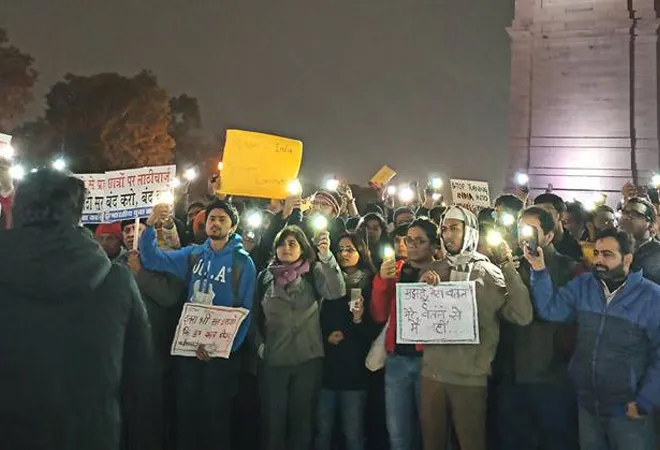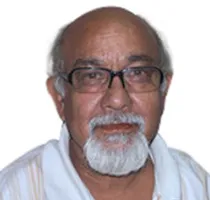
Month-long protests in the national capital and other parts of the country provoke many questions whose answers, if any, may offer some clue to the future of the India and its society. Is a churning on to throw up an alternatative to the presen systemt or is it a temporary phenomenon to wither away soon?
A close look at these non-violent, peaceful and democratic protests that had large number of women, students, youth and a cross section of civil society as participants reveal some interesting facts. Coming out of youth and women in sizable numbers to sustain a movement so long to oppose Citizenship Amendment Act (CAA) 2019 and the National Register of Citizens (NRC) or the National Population Register (NPR) that seeks to change the very definition of an 'Indian citizen', which was agreed and determined by the Constitution, is undoubtedly a new phenomenon.
Notwithstanding, concerted efforts from a certain section enjoying patronage from official and non-official quarters to discredit protests as a pro-Muslim move of the opposition and thus labelling it as anti-national, the movement continued unscathed. Thus, throwing a serious challenge to those forces that brought a regime change in 2014 and have remained at the helm by bettering the mandate at the 2019 general elections.
While the second decade of the 21st century witnessed a powerful movement against corruption that was dominated by the Rashtriya Swyamsevak Sangh (RSS) along with youth and a section of a civil society that resulted in two noticeable outcomes-the rise of the BJP across the country predominantly in Hindi-heartland states along with western states of Gujarat, Goa and Maharashtra. The other change has been the birth of the Aam Admi Party (AAP) led by Arvind Kejriwal and a group of public-spirited civil society activists who were either marginalized over the time forcing them to leave the party in humiliation.
Year 2013-14 saw the AAP winning the Delhi assembly election ousting the Congress from power whose three time chief minister Sheila Dikshit was defeated by none other than Kejriwal who in turn remained the chief minister of Delhi for 49 days. BJP was led to unprecedented victory by the then Gujarat Chief Minister Narendra Modi who in turn became India’s 14th prime minister. The opposition stood divided and scattered bereft of any strategy to take on the Hindutva forces.
With Modi sitting on the prime ministerial chair and the ruling party being controlled by Amit Shah who had worked in tandem with Modi in Gujrat for over two decades, BJP began to spread its footprints across in 21 states covering over 70 percent of the geographical area of the country and Modi-Shah duo being labelled as electorally invincible.
There was, but, one exception and that was of the AAP who under Kejriwal’s leadership had halted the BJP’s march in Delhi assembly elections as early as in February 2015 reducing the saffron party to mere three seats in the 70-member strong assembly and wiping out the Congress from representation totally.
Forces of Hindutva, with full support of the RSS-backed BJP under the command of Modi-Shah duo, were on the march in the country. Anti-knowledge, post-truth forces determined to rewrite the history selectively to lay foundation of a society and a polity in which minorities particularly the Muslims either had no place or at the best as second-class citizens only. Reason appeared powerless standing deflated and defeated creating a feeling of helplessness among those who were respected by those holding reins of political power.
Legislations like scrapping of the Article 370, banning of the Sharia law of verbal triple talaq among Muslims deepened apprehensions. And subsequent passing of the CAA by both the houses of parliament along with the Union Home Minister’s pronouncement of the NRC sounded alarm bells.
Whether the end of the second decade and the beginning of the third decade is witnessing yet another change or not is not clear at the moment?
Academic institutions like Jamia Islamia, Jawaharlal Nehru University, Jadavpur University, Aligarh Muslim University, Banaras Hindu University and many others began to turn restless with students becoming uncomfortable at developments that not only wrecked social peace and harmony but were also seen as a serious challenge to the Constitution.
National flag and the Constitution emerged as the powerful instruments to counter the forces that are determined to replace the idea of India as conceived during the freedom struggle and given concrete shape through long debates in the Constituent assembly with their brand of Hinduism. For these forces, principle of majoritarianism is the governing policy and the guiding spirit.
Since, these protests were spontaneous resulting from frustration and helplessness and had not been designed through deliberations, a clear pattern was not discernable. Because, they had the courage of conviction, therefore, it was not easy to wish them away or dislodge them. Moreover, they were not the creation of any particular political party or outfit.
Therefore, a question needs to be asked whether an alternate vision is in the making? A vision that is seeking to synthesize the best of the both-- the old and the new? A combination of liberal democratic traditions of the freedom struggle that resolutely rejects the outdated and bigoted agenda which promotes aggression, arrogance, hatred and dominance of majority over minority.
Answers to these questions are yet elusive as fight is still on. Struggle is yet to culminate as a new order in making is facing the might of the established order and deeply entrenched vested interests that appear determined to confront than relent.
The mighty and the powerful may overpower the germinating alternative socio-political order for a while prolonging the struggle but, there is no doubt that an idea of a better humane, compassionate and considerate India is in the making.
The views expressed above belong to the author(s). ORF research and analyses now available on Telegram! Click here to access our curated content — blogs, longforms and interviews.




 PREV
PREV


